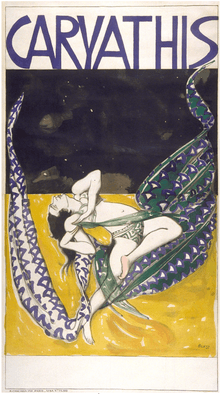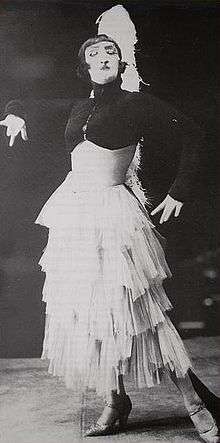La belle excentrique
La belle excentrique (The Eccentric Beauty) is a dance suite for small orchestra by French composer Erik Satie. A parody of music hall clichés, it was conceived as a choreographic stage work and by modern standards can be considered a ballet.[1][2] Satie gave it the whimsical subtitle "fantaisie sérieuse" ("A Serious Fantasy"). It was premiered at the Théâtre du Colisée in Paris on June 14, 1921, conducted by Vladimir Golschmann. The composer later arranged it for piano duet.
Music

Satie composed this set of solo dances between July and October 1920. It was a high-spirited throwback to his turn-of-the-century cabaret idiom after a brief "serious" period that had produced the cantata Socrate (1918) and the piano Nocturnes (1919). The suite consists of three dances (march, waltz, can-can) and an instrumental ritornello:[3]
- 1. Grande ritournelle (Grand Ritornello)
- 2. Marche franco-lunaire (Franco-Lunar March)
- 3. Valse du mysterieux baiser dans l'œil (Waltz of the Mysterious Kiss in the Eye)
- 4. Cancan Grand-Mondain (High-Society Cancan)
Early sketches show that Satie originally planned La belle as "a musical tour through three periods of Parisian popular entertainment" under the following headings: "1900: Marche pour une Grande Cocotte"; "1910: Elégance du Cirque (Ecuyère)"; and "1920: Cancan Moderne."[4] He soon dropped the chronological scheme and proceeded to delve into his own musical past, giving the dances quirky titles that recalled his humoristic piano pieces of the previous decade. For the Grande ritournelle he recycled material from one of his unpublished cabaret songs, Légende californienne, a cakewalk from 1905.[5]
In all the numbers Satie overruled his customary dry irony in favor of a robust (some called it vulgar) vaudeville sensibility.[6][7] The melodies are popular-inspired, the matter-of-fact dance rhythms occasionally whipped along by galloping or stentorian percussion. Despite the lowbrow subject matter Satie was as always scrupulous in his composing methods. He rewrote the opening bars of the Marche 25 times before achieving what he felt was the right level of off-kilter dissonance to mark the title character's first appearance onstage.[8]
Pianist-musicologist Olof Höjer observed that the function and place in the suite of the ritournelle are not entirely clear.[9] Satie evidently intended it as a recurring interlude between the dances to give the performer time to change costumes, but in the first production only one costume was used.[10] The ritournelle also makes an effective introduction and is commonly performed as such, especially in recordings.
The suite is scored for 1 piccolo, 1 oboe, 1 clarinet, 1 horn, 1 trumpet, 1 trombone, percussion for 2 players (snare drum, cymbals, bass drum), and strings. Without reprises of the ritournelle the music lasts about 8 minutes.
History

La belle excentrique was commissioned by the avant-garde dancer and choreographer Élisabeth (Élise) Toulemont (1889-1971), who performed under the stage name Caryathis. A student of Léo Staats, she won notoriety during World War I with her outré interpretations of contemporary music. Her style was rooted in character dance and served up an eclectic mix of classical technique, popular and international dance forms, pantomime, eroticism, and ironic humor.[11] In the early 1920s she threw orgiastic parties at her Paris home, some of which the usually hyper-moral Satie attended with voyeuristic fascination.[12] She later married the novelist Marcel Jouhandeau.
For her first major postwar recital Caryathis collaborated with author and artist Jean Cocteau, who at that time was a spokesman for Satie and the composers of Les Six, and the program they assembled focused primarily on their music.[13] Satie was paid 500 francs each for his three dance numbers; he threw in the Grande ritournelle for free.[14] The title La belle excentrique was coined by Cocteau.[15]
Caryathis began her choreography in October 1920, with Satie protégé Francis Poulenc assisting as a rehearsal pianist. Poulenc wrote to Belgian music critic Paul Collaer that it was "a work of genius."[16] An invitation-only preview was given at the home of actor Pierre Bertin on January 8, 1921.[17] Satie was closely involved in all phases of the project. Couturier Paul Poiret and artists Marie Laurencin, Kees van Dongen, and Jean Hugo were approached to create Belle's costume, but the composer rejected their designs as too charming or too crass. "My music calls for something outrageous," he remarked, "a woman who is more like a zebra than a doe."[18] Cocteau solved the problem by designing a midriff-baring outfit he described as befitting "a mad American woman from the Salvation Army out for revenge."[19] Nicole Groult (Poiret's sister) provided a creepy face mask that hid all but the dancer's eyes.[20]

Cocteau also wrote a programmatic text for La belle that caused friction between the collaborators. He envisioned Belle as an African-American jazz dancer and tried to influence the choreography accordingly, while Satie was adamant that she be thoroughly Parisian. "It's not our fault if Cocteau is stuffed full of his 'jazz' - quite stuffed", Satie told Caryathis.[21] The text does not appear to have been used and no trace of it survives.[22]
The June 14 premiere of Caryathis' one-woman show at the Colisée was well received. One critic noted of her work on La belle, "It seems that what unfolds before our eyes is not ballet, but one of the nightmarish visions of Baudelaire or Edgar Allan Poe."[23] In July 1921 the program moved to Paul Poiret's fashionable garden theatre L'Oasis, where Satie made a rare appearance conducting his music.[24] The original orchestral score and Satie's reduction for piano 4-hands were published by Éditions de La Sirène in 1922. An arrangement of three of the numbers for solo piano (excluding the Cancan Grand-Mondain) also exists.
Caryathis became so identified with her role that she later titled her autobiography The Joys and Sorrows of an Eccentric Beauty.[25] In it she recalled how, in the early summer of 1925, she decided to quit the stage and consigned all the mementos of her career to a fire in her backyard. Her costume for La belle had just started to burn when she received a telegram from composer Georges Auric that Satie was terminally ill in a Paris hospital. She rushed to his bedside for a final reunion, and he died not long afterwards.[26] "Satie appeared not to care about others," she reminisced, "but he had a kind heart, even if it was, certainly, intolerant of stupidity, which he dealt with by irony...His existence was governed by music and his whole life sacrificed to the toil of inspiration and to the pursuit of true knowledge."[27]
Like much of Satie's music, La belle excentrique slipped into obscurity until after World War II. His earliest biographers, Pierre-Daniel Templier (1932) and Rollo H. Myers (1948), found the piece superficial.[28][29] It was first heard in England on June 14, 1949, with Constant Lambert conducting the London Symphony Orchestra in a broadcast for the BBC Third Programme.[30] Pianists Francis Poulenc and Jacques Février made a commercial recording in 1959 (Musidisc). Since then the piano duet version has been more frequently performed, though La belle remains one of Satie's lesser-known compositions.
Recordings
For Orchestra: Maurice Abravanel - Utah Symphony Orchestra (Grande ritournelle only, Vanguard, 1968), Friedrich Cerha - Ensemble "Die Reihe" (Vox, 1970), Bernard Herrmann - London Festival Players (Decca, 1971), Toru Yuki - Danceries Ensemble (Denon, 1987), Michel Plasson - Orchestre Du Capitole De Toulouse (EMI, 1988), and Yutaka Sado - Orchestre Des Concerts Lamoureux (Erato, 2001).
For Piano Duet: Aldo Ciccolini recorded it twice for EMI, overdubbing the second piano part himself in 1971 and paired with Gabriel Tacchino in 1988. Other recordings include those by Jean Wiener and Jean-Joël Barbier (Universal Classics France, 1971, reissued 2002), Chantal De Buchy and Théodore Paraskivesco (PG, 1978), Wyneke Jordans and Leo van Doeselaar (Etcetera, 1983), Anne Queffélec and Catherine Collard (Virgin Classics, 1988, reissued 2008), Jean-Pierre Armengaud and Dominique Merlet (Mandala, 1990), Klára Körmendi and Gábor Eckhardt (Naxos, 1994), Yūji Takahashi and Alain Planès (Denon, 1998), Bojan Gorisek and Tatiana Ognjanovic (Audiophile Classics, 1999), Jean-Philippe Collard and Pascal Rogé (Decca, 2000), Cristina Ariagno (both parts, Brilliant Classics, 2006), Alexandre Tharaud and Éric Le Sage (Harmonia Mundi, 2009), Sandra and Jeroen van Veen (Brilliant Classics, 2013).
For solo piano: Jean-Yves Thibaudet (Decca, 2002).
Notes and references
- A contemporary balletic performance of La belle excentrique is "An Eccentric Beauty Revisited", presented by the New York Theatre Ballet in 2012. See http://www.balletdance.com/201105/NYTB10Mar2012.html
- The Bibliothèque nationale de France, which holds the bulk of Satie's manuscripts, categorizes La belle as a ballet. See http://data.bnf.fr/14794222/erik_satie_la_belle_excentrique__piano/
- http://imslp.org/wiki/La_belle_excentrique_(Satie,_Erik)
- Robert Orledge, "Satie the Composer", Cambridge University Press, 1990, pp. 320-321.
- Orledge, "Satie the Composer", p. 289. Satie registered the music with SACEM on August 18, 1905. The lyrics by Contamine de Latour are lost.
- Pierre-Daniel Templier, "Erik Satie", MIT Press, 1969, pp. 103-104. Translated from the original French edition published by Rieder, Paris, 1932.
- Rollo H. Myers, "Erik Satie", Dover Publications, Inc., NY, 1968, p. 59. Originally published in 1948 by Denis Dobson Ltd., London.
- Orledge, "Satie the Composer", p. 77.
- Olof Höjer, notes to "Erik Satie: The Complete Piano Music, Vol. 6, Swedish Society Discofil, 1996.
- Orledge, "Satie the Composer", p. 344.
- Lynn Garafola, "Legacies of Twentieth-Century Dance", Wesleyan University Press, 2005, pp. 88-89.
- Robert Orledge, "Satie Remembered", Faber and Faber Ltd., 1995, p. 125.
- The finalized program consisted of La belle excentrique, Francis Poulenc's Le Jongleur, Georges Auric's Paris-Sport, Maurice Ravel's Rapsodie espagnole, and an unnamed Spanish dance by Enrique Granados, along with non-choreographed works by Darius Milhaud (Symphonie pastorale) and Arthur Honegger (Pastorale d'été). See Michel Duchesneau, François de Medici, Sylvain Caron, "Music and Modernity in France (1900-1945)", PUM, 2006, p. 103.
- Erik Satie, letter to Caryathis dated November 1, 1920. Cited in Yuri Khanon, "Erik Satie - Retroactive Memories", Faces of Russia, 2010, pp. 675 - 682.
- Steven Moore Whiting, "Satie the Bohemian: From Cabaret to Concert Hall", Oxford University Press, 1999, p. 505.
- Carl B. Schmidt, "Entrancing Muse: A Documented Biography of Francis Poulenc", Pendragon Press, 2001, p. 65.
- Orledge, "Satie the Composer", pp. 320-321.
- Orledge, "Satie Remembered", p. 125.
- Ornella Volta (editor), "Satie Seen Through His Letters", Marion Boyars Publishers, London, 1989, pp. 166-168.
- Ornella Volta (ed.), "Erik Satie: Correspondance presque complete", Fayard, Paris, 2003, pp. 700-701.
- Whiting, "Satie the Bohemian: From Cabaret to Concert Hall", p. 505.
- Michel Duchesneau, François de Médicis, Sylvain Caron (editors), "Musique et modernité en France (1900-1945)", PUM, 2006, pp. 103-104.
- Ornella Volta, "L'Ymagier d'Erik Satie", Paris, Francis van de Velde, 1979, p. 115.
- Mary E. Davis, "Classic Chic: Music, Fashion, and Modernism", University of California Press, 2006, p. 218.
- Elise Jouhandeau, "Joies et douleurs d'une belle excentrique", Paris-éditions Flammarion, 1960.
- On July 1, 1925.
- Orledge, "Satie Remembered", pp. 125-126.
- Pierre-Daniel Templier, "Erik Satie", MIT Press, 1969, pp. 103-104. Translated from the original French edition published by Rieder, Paris, 1932.
- Rollo H. Myers, "Erik Satie", Dover Publications, Inc., NY, 1968, p. 59. Originally published in 1948 by Denis Dobson Ltd., London.
- Stephen Lloyd, "Constant Lambert: Beyond the Rio Grande", Boydell & Brewer Ltd, 2014, p. 519.
'